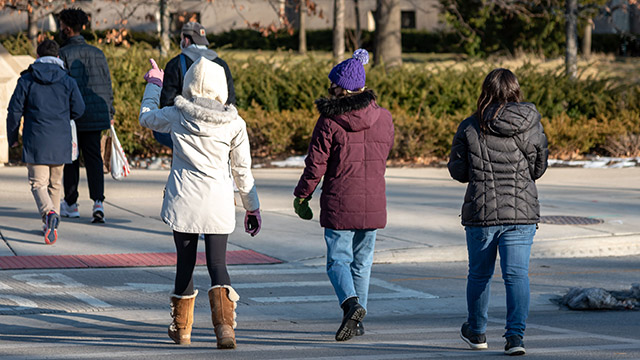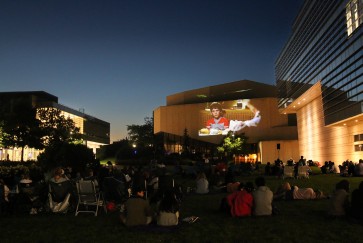With Winter Quarter in full swing, first- and second-year students have joined those who were on campus in fall.
Bringing more students on campus is the ultimate goal, but it also increases Northwestern’s need to closely track existing and new cases of COVID-19 to reduce the spread of the virus and, ultimately, keep campus safe. University health officials do this through a common public health practice known as contact tracing.
“Contact tracing has been used for years by public health officials to slow or stop the spread of infectious diseases,” said Anita Opdycke, PhD, director of Northwestern’s Clinical Practice Services/Operations-COVID Case Management. “This process also helps us identify trends and clusters and to intervene early.”
University vs. non-University exposures
It is important to note that contact tracing occurs for on-campus and Northwestern University-affiliated exposures, and doesn't cover students who live off campus, such as part-time graduate students who live in a different city, Opdycke said. Additionally, local health departments trace people who have non-Northwestern University exposures, so a Northwestern student living in Evanston might be contacted by the Evanston Department of Public Health for contact tracing efforts. Similarly, an individual who lives outside of Evanston would be contact traced by their local health department.
We gathered a series of key points to help explain what contact tracing is and how it works.
Key to the process
“Contact tracing is effective and important because it removes potentially infectious individuals from spreading disease to others,” Opdycke said. “It identifies those who have a higher likelihood of testing positive so we can test them and get them into isolation sooner (thus reducing the spread of COVID). The key is education and prevention.”
How it works
Essentially, contact tracers step into the COVID-positive individual’s shoes to walk through where they’ve been and with whom they’ve interacted in the last two weeks.
“Once someone on campus tests positive for COVID-19, a nurse case manager will reach out within two hours to do an initial interview, symptom review and determine the individual’s infectious period,” Opdycke said. “They would then hand this over to a contact tracer who would work with the individual to identify anyone who met the Centers for Disease Control (CDC) definition of a close contact. They would then reach out to these contacts/exposures and place them into quarantine and tell them to monitor for signs and symptoms of the disease.”
A close contact is defined as someone who has been in contact with an infected individual during that person’s infectious period (previous 48 hours, for 15 minutes, less than six feet apart, with or without a mask on).
During the call, the contact tracer will likely cover standard information, such as:
- Confirmation of identity and demographics
- A basic health screening for COVID symptoms or other COVID risk factors
- How to arrange for a COVID-19 test, if one is recommended
- Required quarantine protocols and reporting documentation
- Instructions for following-up with their personal medical provider (faculty or staff) or NUHS (students).
The case management team would then reach out if needed to get additional details,” Opdycke said. “The person would be asked to complete a daily symptom survey to help Northwestern meet their needs while in isolation.”
How do we know patients are telling the truth?
“We have to trust them,” Opdycke said. “The cornerstone of trust between the patient and the contact tracer is key. We also have to believe that everyone is trying to get us back to a normal and healthy place and will be honest. The contact tracing process is not punitive. The key point is participation in the contact tracing process so that we can stop the spread of any potential COVID infections.”
Technology in use
“Right now we use the SymptomTracker App to monitor symptoms or identify if they were notified of being in close contact with someone who tested positive,” Opdycke said. “When an individual badges red (feeling symptoms including headache, fatigue, sore throat, runny nose, body aches, fever, chills, etc.), they signal our case management team to reach out and triage them. We review symptoms and help facilitate testing.”
When residence hall residents are affected
An undergraduate student living in a Northwestern residence hall who tests positive for COVID-19 will be moved to specialized housing for the period of self-isolation. Northwestern will coordinate cleaning, food service, and other logistics for residential students in self-isolation.
All students, whether residential or off-campus, who are COVID positive, in self-isolation and known to the University have the option to receive tele-health checks from members of the NUHS provider team. They can indicate if they need a follow up telehealth visit by completing their daily symptom survey.
Guidance applies to everyone
“There is no difference in contact tracing between students, faculty or staff members,” Opdycke said. “For all groups, the guidance is the same. We also monitor trends and clusters for all of these groups.”
Playing out “close contact”
Take an entire classroom of students, for example. Are they deemed “close contacts” if they’ve sat in class for more than 15 minutes with someone who tested positive?
“This depends on the class structure, distance between students and what occurred during the class,” Opdycke said.
Read more about what constitutes “close contact” and not.
Does Northwestern mirror the World Health Organization model?
“Yes, in addition to the CDC,” Opdycke said. “We primarily use the CDC alongside our local public health guidance from the Evanston Dept of Public Health (EDPH) and the Illinois Dept of Public Health. I am in close communication with EDPH for guidance and consultation and cluster reporting.”


